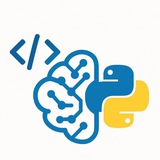Forwarded from Python Data Science Jobs & Interviews
In Python, NumPy is the cornerstone of scientific computing, offering high-performance multidimensional arrays and tools for working with them—critical for data science interviews and real-world applications! 📊
By: @DataScienceQ 🚀
#Python #NumPy #DataScience #CodingInterview #MachineLearning #ScientificComputing #DataAnalysis #Programming #TechJobs #DeveloperTips
import numpy as np
# Array Creation - The foundation of NumPy
arr = np.array([1, 2, 3])
zeros = np.zeros((2, 3)) # 2x3 matrix of zeros
ones = np.ones((2, 2), dtype=int) # Integer matrix
arange = np.arange(0, 10, 2) # [0 2 4 6 8]
linspace = np.linspace(0, 1, 5) # [0. 0.25 0.5 0.75 1. ]
print(linspace)
# Array Attributes - Master your data's structure
matrix = np.array([[1, 2, 3], [4, 5, 6]])
print(matrix.shape) # Output: (2, 3)
print(matrix.ndim) # Output: 2
print(matrix.dtype) # Output: int64
print(matrix.size) # Output: 6
# Indexing & Slicing - Precision data access
data = np.array([[1, 2, 3], [4, 5, 6], [7, 8, 9]])
print(data[1, 2]) # Output: 6 (row 1, col 2)
print(data[0:2, 1:3]) # Output: [[2 3], [5 6]]
print(data[:, -1]) # Output: [3 6 9] (last column)
# Reshaping Arrays - Transform dimensions effortlessly
flat = np.arange(6)
reshaped = flat.reshape(2, 3)
raveled = reshaped.ravel()
print(reshaped)
# Output: [[0 1 2], [3 4 5]]
print(raveled) # Output: [0 1 2 3 4 5]
# Stacking Arrays - Combine datasets vertically/horizontally
a = np.array([1, 2, 3])
b = np.array([4, 5, 6])
print(np.vstack((a, b))) # Vertical stack
# Output: [[1 2 3], [4 5 6]]
print(np.hstack((a, b))) # Horizontal stack
# Output: [1 2 3 4 5 6]
# Mathematical Operations - Vectorized calculations
x = np.array([1, 2, 3])
y = np.array([4, 5, 6])
print(x + y) # Output: [5 7 9]
print(x * 2) # Output: [2 4 6]
print(np.dot(x, y)) # Output: 32 (1*4 + 2*5 + 3*6)
# Broadcasting Magic - Operate on mismatched shapes
matrix = np.array([[1, 2, 3], [4, 5, 6]])
scalar = 10
print(matrix + scalar)
# Output: [[11 12 13], [14 15 16]]
# Aggregation Functions - Statistical power in one line
values = np.array([1, 5, 3, 9, 7])
print(np.sum(values)) # Output: 25
print(np.mean(values)) # Output: 5.0
print(np.max(values)) # Output: 9
print(np.std(values)) # Output: 2.8284271247461903
# Boolean Masking - Filter data like a pro
temperatures = np.array([18, 25, 12, 30, 22])
hot_days = temperatures > 24
print(temperatures[hot_days]) # Output: [25 30]
# Random Number Generation - Simulate real-world data
print(np.random.rand(2, 2)) # Uniform distribution
print(np.random.randn(3)) # Normal distribution
print(np.random.randint(0, 10, (2, 3))) # Random integers
# Linear Algebra Essentials - Solve equations like a physicist
A = np.array([[3, 1], [1, 2]])
b = np.array([9, 8])
x = np.linalg.solve(A, b)
print(x) # Output: [2. 3.] (Solution to 3x+y=9 and x+2y=8)
# Matrix inverse and determinant
print(np.linalg.inv(A)) # Output: [[ 0.4 -0.2], [-0.2 0.6]]
print(np.linalg.det(A)) # Output: 5.0
# File Operations - Save/load your computational work
data = np.array([[1, 2], [3, 4]])
np.save('array.npy', data)
loaded = np.load('array.npy')
print(np.array_equal(data, loaded)) # Output: True
# Interview Power Move: Vectorization vs Loops
# 10x faster than native Python loops!
def square_sum(n):
arr = np.arange(n)
return np.sum(arr ** 2)
print(square_sum(5)) # Output: 30 (0²+1²+2²+3²+4²)
# Pro Tip: Memory-efficient data processing
# Process 1GB array without loading entire dataset
large_array = np.memmap('large_data.bin', dtype='float32', mode='r', shape=(1000000, 100))
print(large_array[0:5, 0:3]) # Process small slice
By: @DataScienceQ 🚀
#Python #NumPy #DataScience #CodingInterview #MachineLearning #ScientificComputing #DataAnalysis #Programming #TechJobs #DeveloperTips
❤4
In Python, image processing unlocks powerful capabilities for computer vision, data augmentation, and automation—master these techniques to excel in ML engineering interviews and real-world applications! 🖼
more explain: https://hackmd.io/@husseinsheikho/imageprocessing
#Python #ImageProcessing #ComputerVision #Pillow #OpenCV #MachineLearning #CodingInterview #DataScience #Programming #TechJobs #DeveloperTips #AI #DeepLearning #CloudComputing #Docker #BackendDevelopment #SoftwareEngineering #CareerGrowth #TechTips #Python3
# PIL/Pillow Basics - The essential image library
from PIL import Image
# Open and display image
img = Image.open("input.jpg")
img.show()
# Convert formats
img.save("output.png")
img.convert("L").save("grayscale.jpg") # RGB to grayscale
# Basic transformations
img.rotate(90).save("rotated.jpg")
img.resize((300, 300)).save("resized.jpg")
img.transpose(Image.FLIP_LEFT_RIGHT).save("mirrored.jpg")
more explain: https://hackmd.io/@husseinsheikho/imageprocessing
#Python #ImageProcessing #ComputerVision #Pillow #OpenCV #MachineLearning #CodingInterview #DataScience #Programming #TechJobs #DeveloperTips #AI #DeepLearning #CloudComputing #Docker #BackendDevelopment #SoftwareEngineering #CareerGrowth #TechTips #Python3
❤3
